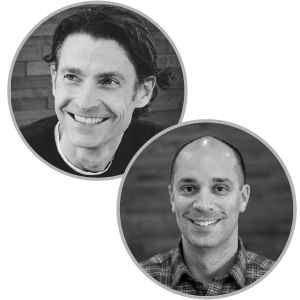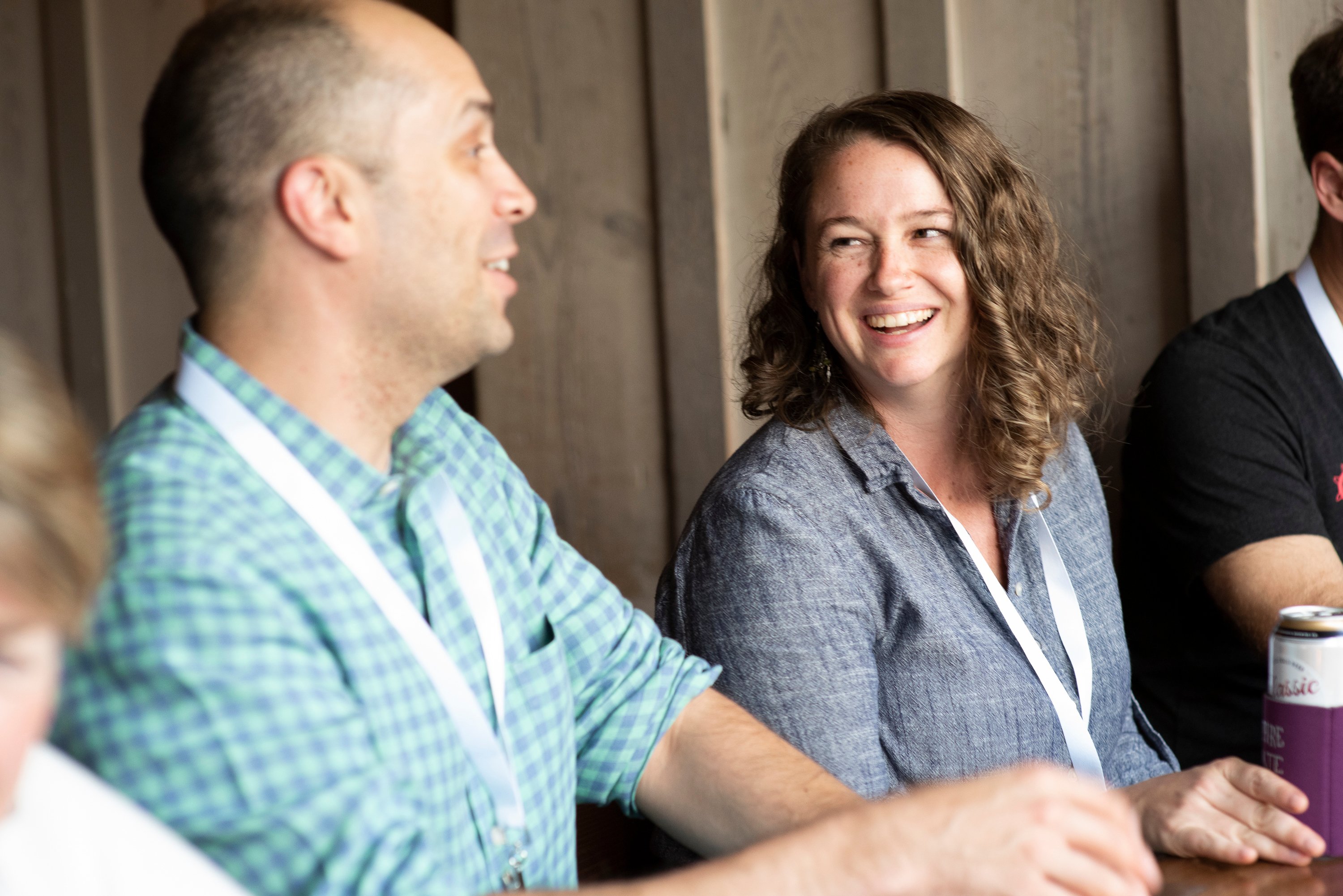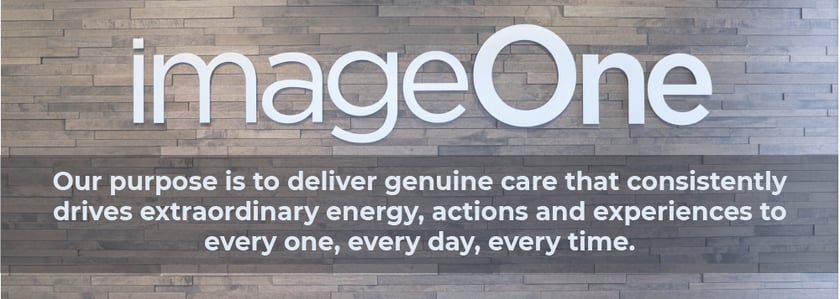Say hello! We’d love to hear from you.
© 2024 Copyright – Small Giants Community. All Rights Reserved

Most mornings, Rob Dubé makes a cup of coffee and settles in near a window in his apartment that overlooks Campus Martius in downtown Detroit. An urban core of the city, Rob loves to observe the energy of thousands of people streaming through and going about their daily lives. On a gray morning in early March, Rob looked down at the familiar landscape of high-rise buildings and was met with a surreal emptiness: almost no one was out there.
Rob and his business partner Joel Pearlman are Co-CEOs of imageOne, a managed print services company based in metro Detroit. The day before, they received word that one of their larger clients would be testing out working from home for the rest of the week. It was March 11th, and the pandemic was just starting to enter mainstream consciousness in Detroit.
“I picked up the phone and called Joel,” says Rob. “I told him what I was seeing — downtown Detroit is nearly empty. This is real, and if other companies follow suit, this is going to hit us hard. Let’s get ahead of this.”
That Friday, imageOne’s executive team gathered for a weekend of intensive planning. Rob and Joel, along with their controller Emily Kmita and president Josh Britton, put themselves to task modeling out the worst-case scenario and financial impact. Pretty quickly, they identified the two priorities that would serve as a litmus test for all of the decisions that lie ahead: they wanted to remain a financially healthy company, and they wanted to protect the financial and mental well-being of their team members. They knew each of those goals couldn’t happen without the other.
“People often wonder if culture really pays off,” says Rob. “This is when we find out if our culture is what we think it is. This is where all of the hard work we’ve put into building our culture shows up. We’ll find out if it’s for real.”
imageOne has clients in eight different states, and as stay-at-home orders went into place around the country, the impact on its business was swift and significant. A large portion of the company’s recurring revenue relies on people being in the office printing pages, and they watched those numbers decline in real time. New business was put on hold, service calls declined — worst case scenario, they predicted a 70 percent drop in revenue.
“Based on our projections, we knew we needed to make deep cuts to payroll,” says imageOne President Josh Britton. “Making cuts to expenses and travel was easy — the painful part was jobs. Rather than resort to lay-offs, we wanted to share the pain with the objective of keeping everyone together. We decided to put it to the team to share ideas on how we could get through this in one piece.”
After briefing the management team, they made plans for an all-hands video conference meeting on Friday morning to share information with the team and bring them into the planning process. They came up with a simple math problem that projected the reduction of revenue in the worst-case scenario. Josh would lay out the situation and ask for the team’s help in finding additional cuts and deciding how to reduce payroll. Starting the next week, each department would meet to come up with alternative ideas for protecting the financial health of the organization.
“Practicing open-book management gave us a head start,” says Rob. “They know the numbers, they know what an income statement is and they understand the importance of cash. Financial transparency really shows up in times like these — there’s no getting people up to speed, they just get it.”
But financial transparency doesn’t make delivering bad news any easier. Friday morning rolled around, and Josh delivered a clear yet vulnerable message to the team: we need to make payroll reductions and we need your ideas on how we can do that. Walking through their projections, they explained the guiding priorities they’d come up with, and showed what it would look like with full compensation and with reductions. In any scenario, Rob and Joel agreed to forgo their pay during this time.
“It was the hardest meeting I’ve ever led,” says Josh. “You’re looking at 62 faces on your screen, and it’s going to impact every single one of them. There were a lot of tears, and there was a lot of shock. But I was most overwhelmed by feeling the energy of the call shift in real time. People immediately fell in love with the idea of keeping this team together.”
One by one, people started chiming in to encourage one another and express gratitude. One person spoke up and said, “We’re a family, let’s stick together.” Another team member gave a 5-minute long, impromptu motivational speech. Of course nobody liked the new reality — pretty much everybody spent the afternoon away from their work, adjusting their family’s budgets and calling creditors, but the energy was positive and united.
“After the call, I broke down,” says Rob. “I’ve never been in a position to make a decision that so widely impacted everyone’s financial situation. It felt surreal, I didn’t know what to do next. It was a difficult moment but also uplifting, because there was so much beauty in how it unfolded.”
By the end of the week, they had nearly one hundred cost-cutting and revenue-generating ideas. Ultimately, the team landed in the same place as the leadership team: they would all take a deep payroll cut.
For the next few days, team members went to work generating new ideas. As each team met, they were guided by the two priorities originally defined by the leadership team: to protect the financial health of the company and the financial and mental well-being of its team members. By the end of the week, they had nearly one hundred cost-cutting and revenue-generating ideas. Ultimately, the team landed in the same place as the leadership team: they would all take a deep payroll cut. Not only that, but team members started stepping up behind the scenes to take additional concessions.
“The true test of one’s character is what they do when no one’s watching,” says Josh. “Team members started calling me offline and offering to be at the back of the line when we start returning to full compensation. They thought others might be struggling more, and they wanted to keep the company together and healthy. Not for merit or accolades – just because they care.”
 Josh interacts with fellow Small Giants Leadership Academy participants.
Josh interacts with fellow Small Giants Leadership Academy participants.
With some team members having more time on their hands, they’re taking the opportunity to get creative and dream up new possibilities for the future. People from across the company have formed an ideation committee for six weeks of facilitated creative thinking. At the end, everyone will take their best idea and pitch it to the company in a Shark Tank style presentation.
“In a way, we’ve been given a gift. We’re using this time wisely,” says Rob. “Most of our competitors have laid off at least a third of their staff, and eventually, they’re going to have to retool and get people back in and get organized. We know that we’re stronger together, and we’re proving that we can get through anything.”
Every day is a new day in this crisis, and imageOne’s worst-case scenario projections have yet to come to fruition. So far, the decline in revenue hasn’t been as bad as predicted, so team members haven’t taken the full paycheck reduction they planned for. imageOne also secured a Paycheck Protection Program (PPP) loan, and the team will be back to full compensation by the time the next paycheck hits their bank accounts. With things changing so quickly, the key is staying close and keeping everyone well-informed.
“Information is top priority,” says Josh. “Without it, negative talk gets going and people can make assumptions and it causes panic. We meet regularly and we’re open, honest, and transparent. Information automatically lowers the temperature for everyone.”

On paper, the events of the last month would be catastrophic for a small business like imageOne. But all the work they’ve done to define their purpose provides a strong foundation for navigating this new terrain. To ensure they are genuinely caring for team members through this time, they started surveying everyone three times a week: do you feel cared for, connected, and informed? It’s now a company metric included in their scorecard, and the goal is to have 90 percent of team members reporting positively.
Even with social distancing, the team is staying close and keeping tabs on each other’s overall health and wellness. imageOne uses a method called the Simple Six to meaningfully check in with team members and the most important aspects of their well-being: meditation, sleep, nutrition, movement, connection, and gratitude. It’s a practical list that tends to uncover underlying issues pretty quickly, and gives leadership an opportunity to provide support. In the battle of crisis versus culture, culture is winning at imageOne.
They started surveying everyone three times a week: do you feel cared for, connected, and informed? It’s now a company metric included in their scorecard.
“This is a reshuffling of the deck that really caters to people who are purpose-driven,” says Josh. “I have a deep sense of hope and faith in this moment, and that comes from the 61 other people in this company. That’s the only place I need to look to believe in what we’re doing, why and who we’re doing it for.”
These leaders are part of Small Giants companies — companies that prioritize their purpose and culture and invest in their emerging leaders.
One way Small Giants companies invest in their next generation of leaders is by enrolling them in the Small Giants Leadership Academy. This robust one-year certification program consists of virtual learning sessions with expert leaders and coaches, an extensive resource library, on-the-ground meetups with your cohort, a leadership assessment, and your event ticket to two Small Giants gatherings.
© 2024 Copyright – Small Giants Community. All Rights Reserved
Small Giants Community Program Director
Virtual Position
The Small Giants Community is hiring! Are you looking for a job where you get to work remotely with a hard-working, tight-knit team? Do you like talking about values-based businesses, inspiring leadership stories, and Ted Lasso? Boy, do we have the job for you!
We’re a high-performing team working hard to grow the Small Giants Community, an organization committed to identifying, connecting, and developing purpose-driven business leaders. Our network spans more than 6,000 leaders, 300 companies, and 28,000 employees who are growing with intention, and we believe that more and more people are beginning to see the value in purpose-driven business.
Basically, we’re a small but mighty team. We’re energized by coffee, the sun and leaders doing great things in the world via their companies. We’re looking for someone to add value to our team with their own unique skills, motivations, and experience. This person has to be flexible and able to manage their own workload deftly while also being incredibly team-oriented.
Position Overview:
We are seeking a highly motivated individual to join the Small Giants Community as a Full-Time Program Director. In this role, in collaboration with the executive director, you will be responsible for overseeing and managing various programs including the Summit, Leadership Academy, Sounding Board, content development, and our marketing efforts. You’ll also be responsible for cultivating relationships and managing a team. You will play a vital role in shaping and driving the organization’s mission to foster values-driven leadership and promote a community of purpose-driven businesses.
Responsibilities:
Key Qualifications:
Benefits & Perks:
About the Small Giants Community team:
Our Purpose
To identify, connect, and develop purpose-driven business leaders.
Our Core Values
Trust Each Other: We understand that the team will thrive when we fully trust one another and assume the best intentions, support one another, and work toward a common goal.
Grow with Purpose: We continuously invest in our learning and development, seeking new opportunities to grow our skills and strengthen our weaknesses so that we can better serve the Community.
Work Mindfully: We prioritize meaningful, quality work over everything. We’re committed to being present with the current objective and giving it our full attention, providing the best possible opportunities and resources to our Community.
Create Great Experiences: We are committed to doing things differently. We understand that the Small Giants difference is high-class, personal and meaningful experiences that result in lifelong learning and lasting relationships.
Be Responsive: We believe in meeting and exceeding the promises we make. In working with each other and with customers, we are responsive and accountable.
Sounds like an interesting opportunity and/or want to learn more? Email your resume and cover letter to hamsa@smallgiants.org.
